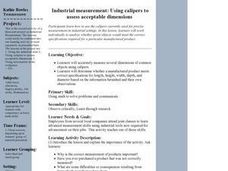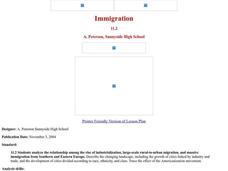Library of Congress
Industrial Revolution
Could you live without your phone? What about cars, steel, or clothing? Class groups collaborate to produce presentations that argue that either the telephone, the gramophone, the automobile, the textile industry, or the steel industry...
Curated OER
The Industrial Age in America: Sweatshops, Steel Mills, and Factories
Young scholars investigate the working conditions during the Age of Industrialization. They research how workers reacted to the conditions and discuss the results of labor movement.
Syracuse University
American Industrial Revolution
While the Industrial Revolution may have fueled America's rise to the top of world markets, the child laborers often faced dangerous conditions. Using primary source images and other information, scholars consider what these children...
Center for History Education
To What Extent Were Women's Contributions to World War II Industries Valued?
Women rose to the challenge when the nation's war effort called them—but were sent home when the GIs came back from World War II. Young historians consider whether the United States valued women's contributions during the war using a...
Curated OER
Reformers versus Residents in Five Points: A Role Play
Social Studies and role-playing can go hand in hand. Learners use supporting evidence found in primary and secondary source material to develop a character from the Five Points neighborhood in the 1850s. Each student takes on the role of...
Curated OER
Fun-Factory - NOT!
Middle schoolers design a solution to a problem based on the Industrial Revolution. In this design lesson plan, students come up with architectural designs and present them to teachers in a simulated factory.
Curated OER
The Industrial Age in America: Robber Barons and Captains of Industry
Young scholars define terms "robber baron" and "captain of industry," list positive and negative actions of one or more captains of industry/robber barons, and take and support stand as to whether particular financier/industrialist is or...
Curated OER
The Inventions and Effects of the Industrial Revolution
Young scholars understand that the Industrial Revolution began in England, spreading to the rest of Western Europe and the United States and with it came an increased demand for raw materials from the Americans, Asia, and Africa.
Curated OER
Time For Change
Students examine and discuss the inventions and changes created by the Industrial Revolution. They create posters or clay models about inventions, write paragraphs about the advantages and disadvantages of the changes, and develop a...
Curated OER
Wings, Chrome, and Tailfins: Automobiles of the 1950s
Students study the automobile industry. In this cultural history lesson, students explore 1950s America as they view a teacher-created PowerPoint presentation regarding the 1950s. Students research how the automobile changed the 1950s...
Curated OER
Sea Changes: A New England Industry
Students conduct research in order to use primary and secondary sources. They interpret and analyze information from textbooks and nonfiction books for young adults, as well as reference materials, audio and media presentations, oral...
Curated OER
Industrial Measurement: Using the Industrial Ruler
Students accurately measure several common objects using the industrial ruler. They work individually to analyze whether given objects would meet the correct specifications required for a particular manufactured product.
Pulitzer Center
China's Rising Labor Movement
Young historians will explore the complex causes and effects of industrialization in China by perusing the numerous articles included in this webpage. Throughout the resource, there are many writing and discussion prompts to help direct...
Syracuse University
Erie Canal
While canals are not the way to travel today, in the first half of the nineteenth century, they were sometimes the best way to move goods and people. Scholars examine primary sources, including maps and pictures, to investigate the role...
Curated OER
Industrial Measurement: Using Micrometers in the Workplace
Students accurately measure several common objects for thickness using micrometer calipers. They work individually to analyze whether given objects would meet the correct specifications required for a particular manufactured product.
Curated OER
Industrial Measurement: Using Calipers to Assess Acceptable Dimensions
Students accurately measure several dimensions of common objects using calipers. They determine whether a manufactured product meets correct specifications for length, width, height, depth and diameter.
University of Wisconsin
Why Did the Triangle Fire Occur?
An investigation of the 1911 New York City Triangle Shirtwaist Factory fire leads class members to examine primary and secondary source materials related to the event and apply what they learn about the working conditions at the time to...
Curated OER
Images from South Carolina Cotton Mills
Fifth graders write a paragraph comparing their lives to the lives of a child working in South Carolina during the early 1900's. In this Industrial Revolution lesson plan, 5th graders explore primary and secondary sources to teach them...
Curated OER
Child Labor in America
Learners interpret historical evidence presented in primary and secondary sources. In this child labor instructional activity, students examine the issue of child labor and determine how citizen...
Curated OER
The Automobile’s Influence on Post-WWII Suburbia
Eighth graders explore post World War II America. In this American History lesson, 8th graders analyze primary and secondary sources to research how the automobile influenced the growth of suburbs, and how the growth of suburbs...
Curated OER
Immigration
Students explore the concept of immigration. For this immigration lesson, students read literature, analyze photographs, and evaluate political cartoons that reflect feelings about immigration in America during Industrialization....
Curated OER
Child Labor in the Carolinas
Fifth graders explore child labor and how children were exploited and used in the work place. In this Industrial Revolution lesson plan, 5th graders research child labor by reading, looking at photographs and drawing conclusions then...
Curated OER
Immigration History Firsthand
Young scholars interpret historical evidence presented in primary and secondary resources. In this immigration lesson, students conduct research regarding Ellis Island and the American immigrant experience. Young...
American Institute of Physics
Historical Detective: Edward Alexander Bouchet and the Washington-Du Bois Debate over African-American Education
Young scientists meet Edward Alexander Bouchet who, in 1876, was the first African American to receive a PhD in Physics. This two-part lesson first looks at the debate between Booker T. Washington and W.E.B. Du Bois about the type of...

























